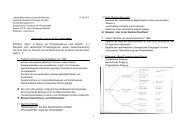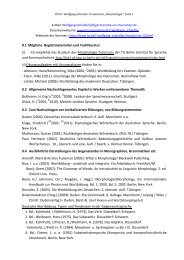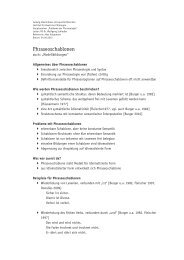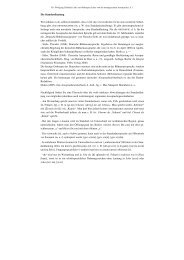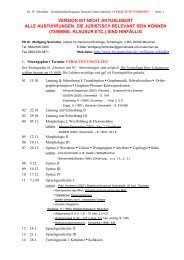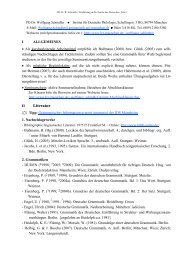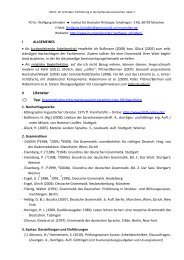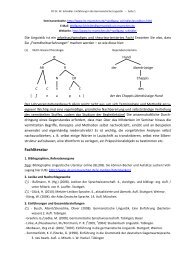Chapter 18 Lexical Functions: Description of Lexical Relations in a ...
Chapter 18 Lexical Functions: Description of Lexical Relations in a ...
Chapter 18 Lexical Functions: Description of Lexical Relations in a ...
You also want an ePaper? Increase the reach of your titles
YUMPU automatically turns print PDFs into web optimized ePapers that Google loves.
—<strong>Chapter</strong> <strong>18</strong>. <strong>Lexical</strong> <strong>Functions</strong>— 58<br />
Incep(ljubit´ (love)) = //po+ljubit´, ... [‘//’ <strong>in</strong>dicates, as was said several times, fused elements <strong>of</strong><br />
an LF value]. Compare as well: Incep(burn [<strong>in</strong>trans.]) ≈ //catch fire; flare up (with addition <strong>of</strong><br />
(<strong>in</strong>tensely) = Magn, i.e., we have here [Magn + Incep](burn)); or else F<strong>in</strong>(sleepV) = //awakeV.<br />
49-51. Causation verbs<br />
The LFs 49-51 express the mean<strong>in</strong>g <strong>of</strong> causation: 17<br />
Caus [Lat. causāre] means (cause) [≈ (do someth<strong>in</strong>g so that a situation beg<strong>in</strong>s occurr<strong>in</strong>g)]<br />
Perm [Lat. permittere] means (permit/allow) [≈ (do noth<strong>in</strong>g which would cause that a situation<br />
stops occurr<strong>in</strong>g)]<br />
Liqu [Lat. *liquidāre] means (liquidate) [≈ (do someth<strong>in</strong>g so that a situation stops occurr<strong>in</strong>g)]<br />
Thus, these LFs are semantically full.<br />
negation:<br />
Very much like phasal LFs, these LFs are also l<strong>in</strong>ked by semantic relations based on<br />
Liqu(P) = AntiCaus(P) = Caus(NonP)<br />
Perm(P) = NonLiqu(P) = NonCaus(NonP)<br />
And also like phasal verbal LFs, the causation LFs are <strong>of</strong>ten used <strong>in</strong> comb<strong>in</strong>ation with other<br />
verbal LFs.<br />
Examples<br />
CausOper 1(op<strong>in</strong>ion) = lead [NX to ART ~]<br />
PermFunc 0(aggression) = condone [ART ~]<br />
CausFunc 0(crisis) = br<strong>in</strong>g about [ART ~]<br />
LiquFunc 0(aggression) = stop [ART ~], put an end [to ART ~]<br />
LiquFunc 0(traces) = wipe out [ART ~]<br />
CausFunc 1(hopeN) = raise [~ <strong>in</strong> NX]<br />
Yet they can also be found (depend<strong>in</strong>g on the language) outside <strong>of</strong> complex LFs: thus, <strong>in</strong><br />
Russian we have:<br />
Caus(pit´ (dr<strong>in</strong>k)) = //poit´ Caus(serdit´sja (be angry)) = //serdit´<br />
Caus(spat´ (sleep)) = //usypit´ Caus(katit´sja (roll [<strong>in</strong>trans.])) = //katit´<br />
Remarks<br />
1. Causation LFs and the actantial structure <strong>of</strong> complex LFs with their participation. Unlike all the<br />
other LFs, which never change the actantial structure <strong>of</strong> the LU L referr<strong>in</strong>g to a given situation, a<br />
causation LF <strong>in</strong>troduces, as a general rule, a new SemA and, as a consequence, a new DSyntA:<br />
the Causer/the Cause. The Causer/the Cause is expressed as DSyntA I <strong>of</strong> the causation LF, and


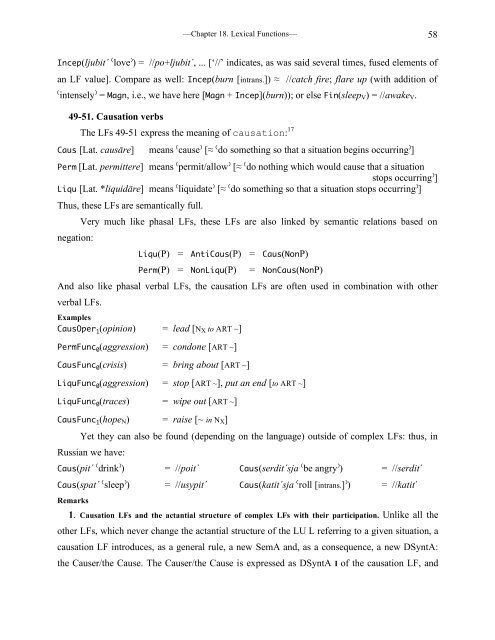
![E-Mail: Wolfgang.Schindler[ätt]germanistik.uni-muenchen.de Web ...](https://img.yumpu.com/51590147/1/184x260/e-mail-wolfgangschindlerattgermanistikuni-muenchende-web-.jpg?quality=85)
